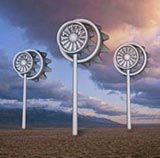
Jet Engine Technology Boosts Wind Turbine Performance
A new wind turbine design could generate electricity at half the cost of conventional wind turbines. The design uses jet engine technology which circumvents a fundamental limit to conventional wind turbines. Typically, as wind approaches a turbine, almost half of the air is forced around the blades rather than through them, and the energy in that deflected wind is lost. At best, traditional wind turbines capture only 59.3 percent of the energy in wind, a value called the Betz limit.
Jet engine design increases wind turbine power
The turbine design surrounds its wind-turbine blades with a shroud that directs air through the blades and speeds it up, which increases power production. The shroud concept is based on the same principles as a high bypass jet engine design that is used by all commercial jet aircraft engines to reduce noise and significantly improve efficiency. The new design generates as much power as a conventional wind turbine with blades twice as big in diameter. The smaller blade size and other factors allow the new turbines to be packed closer together in the field compared to conventional turbines, increasing the amount of power that can be generated per acre of land.
From the front, these wind turbine looks something like the air intake of a jet engine. As air approaches, it first encounters a set of fixed blades, called the stator which are common in jet and steam turbines designs used in power generation, which redirect the air onto a set of movable blades, called the rotor. The air turns the rotor and emerges on the other side, moving more slowly now than the air flowing outside the turbine. The shroud is shaped so that it guides this relatively fast-moving outside air into the area just behind the rotors. The fast-moving air speeds up the slow-moving air, creating an area of low pressure behind the turbine blades that sucks more air through them.
Two to three times the power output of conventional turbines
It's plausible that such a design could double or triple a turbine's power output, says Paul Sclavounos, a professor of mechanical engineering at MIT. Part of the increase comes simply from guiding the air to the turbine with the shroud. But Sclavounos notes that it also helps to use the wind surrounding the turbine to speed up the airflow, because the power produced by a wind turbine increases with the cube of the wind speed. The key question is whether the new turbines can be built and maintained at a low-enough cost. Shrouded turbines can be half to a third the size of a conventional 30+ story tall 3 blade turbine for the same power output and with tall towers and blades up to 90 meters long transportation alone can make up to 20% of turbine construction costs so a shrouded turbine may lead to significant reduction in construction costs and as a result cheaper power generation.
The wind turbine is being developed by FloDesign,a spin-off from the aerospace company FloDesign based in Wilbraham, Massachusetts.
Jet Engine Technology Boosts Wind Turbine Performance copyright 2011 Digtheheat.com
